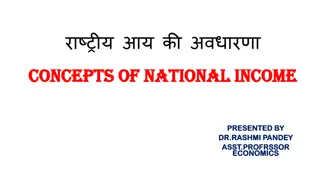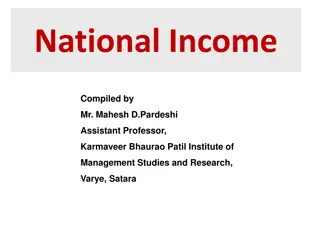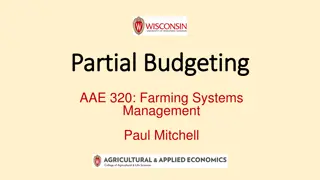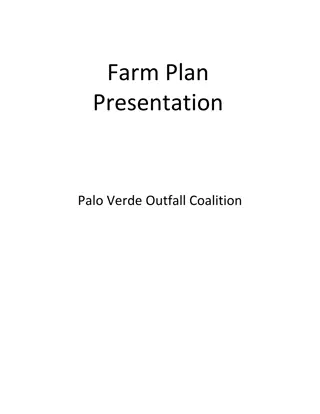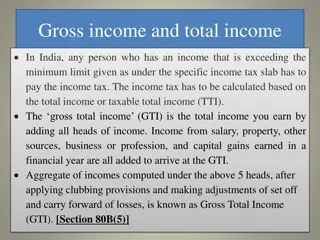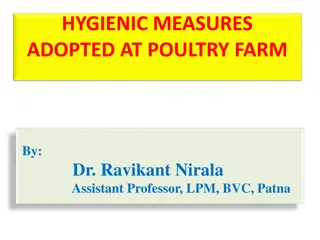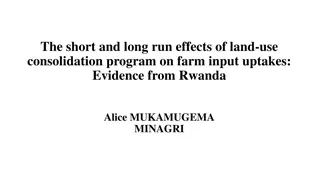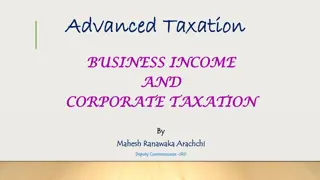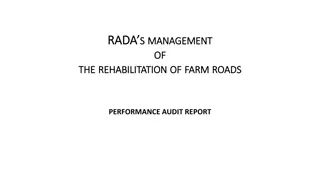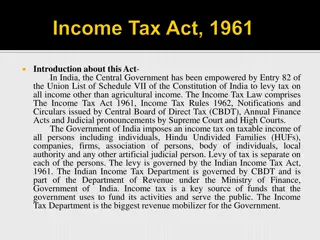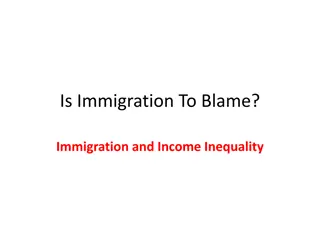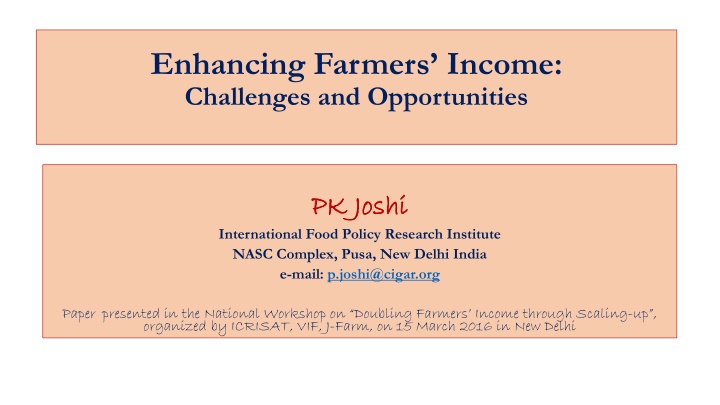
Challenges and Opportunities in Enhancing Farmers' Income
Explore the challenges and opportunities farmers face in increasing their income, focusing on income sources, yield increase, wage rates, value of produce, agricultural diversification, and crop contributions. Learn about the importance of diversification, the falling share of crop sector, and the significance of high-value crops in overall growth.
Download Presentation

Please find below an Image/Link to download the presentation.
The content on the website is provided AS IS for your information and personal use only. It may not be sold, licensed, or shared on other websites without obtaining consent from the author. If you encounter any issues during the download, it is possible that the publisher has removed the file from their server.
You are allowed to download the files provided on this website for personal or commercial use, subject to the condition that they are used lawfully. All files are the property of their respective owners.
The content on the website is provided AS IS for your information and personal use only. It may not be sold, licensed, or shared on other websites without obtaining consent from the author.
E N D
Presentation Transcript
Enhancing Farmers Income: Challenges and Opportunities PK Joshi PK Joshi International Food Policy Research Institute NASC Complex, Pusa, New Delhi India e-mail: p.joshi@cigar.org Paper presented in the National Workshop on Doubling Farmers Income through Scaling-up , organized by ICRISAT, VIF, J-Farm, on 15 March 2016 in New Delhi
Background Income sources 48% cultivation; 32% wages; 12% animal husbandry; 8% non-farm activities Income from crop = (Production X Price) Cost (Area X Yield X Price) {(input quantities X Prices) + (wages X labor)} Area expansion Net sown area remains around 140 m ha Cropping intensity was below 140% Yield increase During last 15 years, rice yields increased only 680 kgs (45 kg/year) Wheat: 835 kg (55 kg/year) Chickpea: 250 kg (17 kg/year); Pigeon pea: 177 kg (12 kg/year)
Rising wage rates and wage-share in value of produce Gross value of produce Rs/ha Hourly Wage (Rs) in Bihar Hourly Wage (Rs) Paddy price (Rs/q) Labor used (hour) Total wage bill (Rs) Wage share (%) of GVP 20 Yield (Q/ha) Year 18.37 18 16.34 2004 6.21 504 875 5433 23 11494 47 16 2005 6.47 478 831 5379 26 12331 44 14 2006 6.76 531 840 5676 25 13329 43 12 11.83 10.14 2007 7.21 632 771 5556 29 18318 30 10 9.32 2008 9.32 726 797 7423 27 19344 38 8 6.216.476.767.21 2009 10.14 856 768 7784 19 16244 48 6 2010 11.83 968 757 8954 19 18680 48 4 2 2011 16.34 830 797 13023 28 22881 57 0 2012 18.37 977 808 14842 24 23695 63 2004 2005 2006 2007 2008 2009 2010 2011 2012
Is agricultural diversification an important source of increasing incomes? Share of crop sector is falling Rice, wheat, coarse cereals, pulses, oilseed Livestock sector is gaining Dairy and poultry Fisheries is also improving Marine to inland Agriculture growth was largely driven by livestock and horticulture sectors Sector-wise share in value of agril. output % 70 65.9 65.1 62.5 61.25 60 50 40 30 25.4 23.7 21.6 18.6 20 13.4 9.8 9.5 8.9 10 4.5 4.3 3.5 3.1 0 Crop Livestock Forestry Fishery 1980s 1990s 2000s 2010/11
Contribution of high Contribution of high- -value crops to overall growth, % value crops to overall growth, % Item Item Compound Compound growth in real value (per growth in real value (per annum) annum) Share in overall growth (%) Share in overall growth (%) 1980s 1980s 1990s 1990s 2000s 2000s 1980s 1980s 1990s 1990s 2000s 2000s Cereals Cereals 2.0 2.0 3.6 3.6 0.7 0.7 30.7 30.7 43.0 43.0 6.9 6.9 Pulses Pulses 2.0 2.0 1.0 1.0 3.0 3.0 4.6 4.6 0.3 0.3 4.8 4.8 Oilseeds Oilseeds 6.9 6.9 - -0.7 0.7 5.4 5.4 21.4 21.4 - -2.6 2.6 13.0 13.0 Fibers Fibers 1.7 1.7 2.6 2.6 9.9 9.9 4.8 4.8 1.8 1.8 14.7 14.7 S cane S cane 1.2 1.2 5.0 5.0 0.0 0.0 3.8 3.8 13.1 13.1 - -1.3 1.3 Horti Horti 4.6 4.6 6.3 6.3 5.8 5.8 33.9 33.9 44.6 44.6 60.0 60.0 Other Other 0.9 0.9 1.0 1.0 6.8 6.8 0.8 0.8 - -0.1 0.1 2.0 2.0 All All 3.1 3.1 3.7 3.7 3.3 3.3 100 100 100 100 100 100
Contribution of various sources to overall growth Contribution of various sources to overall growth 120 100 0.5 1.0 1.3 26.3 31.2 33.3 80 5.2 Percent 7.2 60 24.3 51.5 39.4 40 32.3 20 21.2 16.5 8.7 0 1980s 1990s 2000/01-2009-10 Area Yield Price Diversification Interaction
Potential and constraints Unorganized agriculture sector Way of life; no business model Small and fragmented size of holdings 1.84 ha in 1980/81 to 1.15 ha Average size of holding of 85% holdings is 0.61 ha 0.39 ha of 63% holdings (marginal, part of smallholding category) Poor adoption of improved varieties and technologies North-west India versus eastern India Diversion and degradation of soil and water resources Weak market linkage Low marketable surplus Climate change Potential exists to raise income (Pratap Birthal, 2017) Low income marginal farmers: - Rs 6K/annum/holding High income marginal farmers: - Rs 50k/annum/holding) Low income marginal farmers largely concentrated in Eastern India
Important government programs and policies Prime Minister Irrigation Scheme National Micro irrigation Mission Integrated Watershed Management Program National Food Security Mission National Horticulture Mission Bringing Green Revolution in Eastern India National Mission on Sustainable Agriculture Prime Minister Fasal Bima Yojana (Agriculture insurance) Agriculture extension system Research system KVKs ATMA Agricultural marketing: MSP, e-NAM; warehouse receipt, commodity exchange
Way forward Promote high potential allied activities Horticulture, livestock, fisheries Farming with business model Market driven agriculture Primary/secondary processing, branding and retailing Aggregation of production and marketing Farmer Producer Organizations (SFAC) Inclusive market reforms Correct frontend Invest in agriculture (investment in irrigation, agricultural research, education and health) Convergence of programs
Thank you 11

